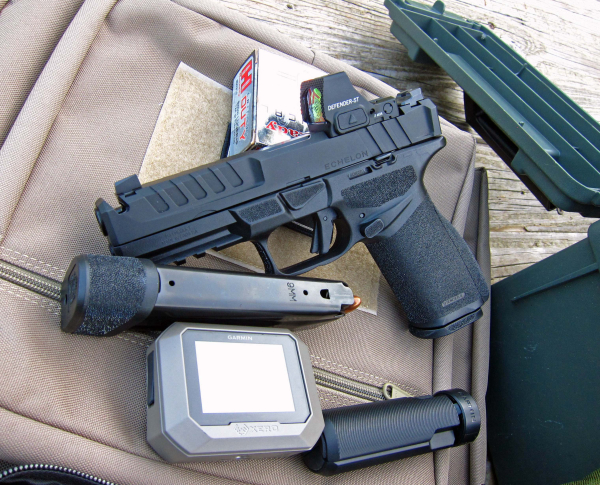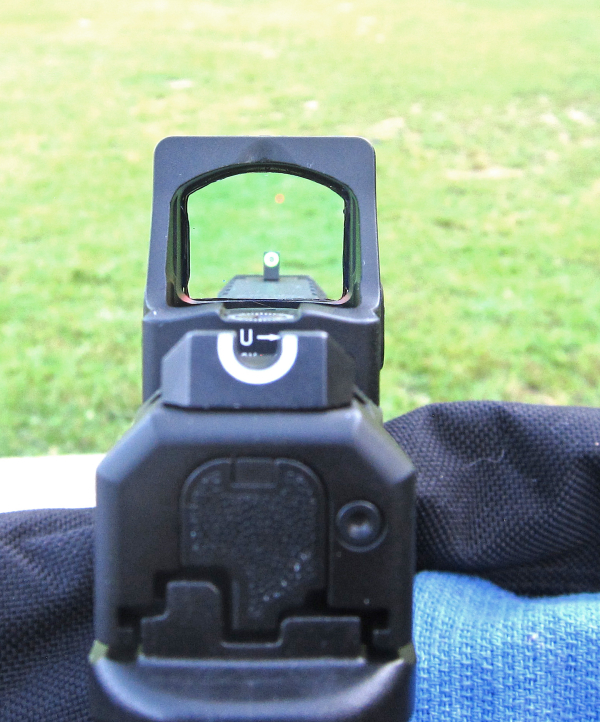First, Springfield Armory cut the barrel and slide on the Hellcat Pro to make a bit of a recoil compensator. Then they did similar surgery with the 1911 DS Prodigy Comp AOS.

Now it’s the Echelon’s turn. Like the other Springfield Comp pistols, the front sight is moved behind the compensator cuts. Like others in the Echelon line, the new gun has the Variable Interface System, a low direct-mount solution to optics mounting.
The Echelon is more service pistol than concealed carry pistol, though it’s no problem to carry the gun discreetly if properly holstered. It carries lots of ammo in the supplied 17- and 20-round magazines. The empty gun, with flush magazine, weighs under 24 ounces. It’s slightly over with the extended magazine.
Operating controls – slide stop and magazine catch – are bilateral on this beast, with the disassembly lever on the left-side only. The slide is nicely sculpted with grasping grooves fore-and-aft, with a bit of a flare at the rear of the slide to enhance manual operation.
The frame, like previous versions, is nicely finished in a grippy stippling pattern.

So why a barrel/slide port? It’s not like the Larry Kelly Mag-Na-Port days when we sent our hard-kicking 44- and 41 Magnum revolvers to Michigan for the patented barrel porting. These are all 9mm pistols.
Well, you get back on target quicker after a shot. But, as a service (and defense) pistol, we need to shoot these things in assessment time, not human response time (which is quicker and less discriminating).
Consider the fact that some of us have joint/tendon issues either a result of aging or an active lifestyle. That’s relevant. Concerns that the flare from a ported barrel could “wreck your night vision” isn’t really the point as you need enough light to visually identify the threat anyway; that’s enough for that problem.
The “comped” pistol is another option. For those who don’t have the tendonitis or other joint issues, it may not be needed.
The sample gun arrived with a Vortex Defender-ST optic pre-mounted. I’m glad it did, otherwise I may have never gotten to assess that particular glass.

The 3-MOA dot is more than precise enough for the intended purpose.
Starting with a zero check and accuracy work at 25 yards, I found that the Hornady Critical Duty 135 grain FTX +P round, a good fit for this pistol, averaged 1158 fps and shot into 4 1/4”. One of those rounds was a flier, with four rounds going into 1 1/8”.
Federal Personal Defense 124 grain Punch hit 1,154 fps and put four of five rounds into 1 5/8”. Black Hills 115 grain JHP-EXP averaged 1,244 fps and put five rounds into 3 7/8”, with four of those rounds into 2”. To check with a heavy bullet load, I used old stock Remington Golden Saber 147 grain Brass Jacket Hollow Point. It averaged 982 fps and put five hits into 4 5/8”. The best three clustered into an inch and a half.
The gun had no clear favorites.
I ended shooting two-handed at fifteen yards into a B-8 repair center with Monarch 115 grain FMJ “Brass,” from Academy Sports. The headstamp reads “PPU.”
Five rounds fired right hand supported scored a fifty, with three in the “X” ring. Shooting left-handed yielded a score of 50 as well, with three Xs. I tended to the left shooting right-handed and to the right shooting left-handed.
That’s my struggle.
On this trip, I definitely needed an optics cleaning cloth. There was dark particle residue on the glass of the optic from the 80 or so rounds I fired. I didn’t notice the shot residue from shooting the Hellcat Pro Comp, so it could be unique to this offering – or to the ammo.
On a second trip, I shot back to 40 yards with some old carry ammo and some Sellier & Bellot 115 grain FMJ ammo. Using the FLETC-type “Trans” target, I shot from three yards, with the “Immigration” qual “bent elbow” technique. The word out there is that shooting from retention with ported guns equals injury to the shooter. That’s something to be checked.
I detected no issues from the six rounds, drawing from the DeSantis Speed Scabbard used for a previous sample of the Echelon. All hits were centered.
I did a walk-back, ending at forty yards with only three rounds remaining in the gun. One hit was in the center ring, one clipped the top of the second scoring ring, and the third was left, just over the “shoulder” but still on the target.
The shooter could use some adjustment. The gun – and the Vortex optic – worked just fine, as did the ammo. And I found no soot on the glass of the optic.
I’m thinking that was ammo-specific or it had to do with environmental conditions on that outdoor range on that day.

Like other current Springfield pistols, this one comes with a double-zipper case. It has an interior pouch to carry the spare magazine. It’s a nice touch.
Do you need the Echelon Comp? I’m quite fond of the Echelon line thus far; striking appearance, excellent ergos, frame texturing is just right, sights are top flight, more than enough accuracy – there’s nothing not to like. As I didn’t have the non-ported version here, there’s no comparison between the two.
If the muzzle flip reduction reaches out to you, this is your Springfield Armory striker-fired service pistol. If not, the regular Echelon is still in the line. You’ll be fine either way.
— Rich Grassi